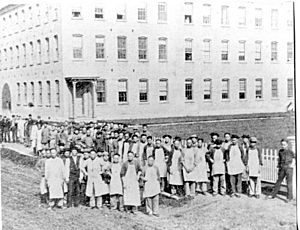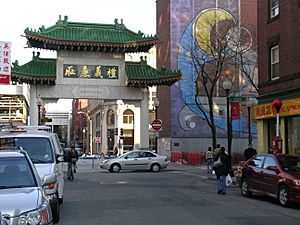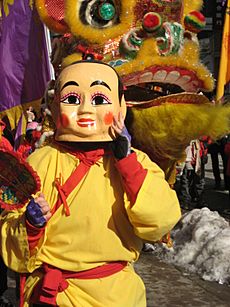Chinatown, Boston facts for kids
Quick facts for kids
Chinatown
|
|||||||||||||||||||||||||||||||||||||||||||||||||||||||||||||||||||||||||
|---|---|---|---|---|---|---|---|---|---|---|---|---|---|---|---|---|---|---|---|---|---|---|---|---|---|---|---|---|---|---|---|---|---|---|---|---|---|---|---|---|---|---|---|---|---|---|---|---|---|---|---|---|---|---|---|---|---|---|---|---|---|---|---|---|---|---|---|---|---|---|---|---|---|

The paifang gate in 2013
|
|||||||||||||||||||||||||||||||||||||||||||||||||||||||||||||||||||||||||
| Country | United States | ||||||||||||||||||||||||||||||||||||||||||||||||||||||||||||||||||||||||
| State | Massachusetts | ||||||||||||||||||||||||||||||||||||||||||||||||||||||||||||||||||||||||
| County | Suffolk | ||||||||||||||||||||||||||||||||||||||||||||||||||||||||||||||||||||||||
| Neighborhood of | Boston | ||||||||||||||||||||||||||||||||||||||||||||||||||||||||||||||||||||||||
| Time zone | UTC-5 (Eastern) | ||||||||||||||||||||||||||||||||||||||||||||||||||||||||||||||||||||||||
| Zip Code |
02111
|
||||||||||||||||||||||||||||||||||||||||||||||||||||||||||||||||||||||||
| Area code(s) | 617 / 857 | ||||||||||||||||||||||||||||||||||||||||||||||||||||||||||||||||||||||||
|
|||||||||||||||||||||||||||||||||||||||||||||||||||||||||||||||||||||||||
Chinatown, Boston is a lively neighborhood in downtown Boston, Massachusetts, United States. It's the only historic Chinese community left in New England. This area is home to many Asian Americans, which means you'll find lots of amazing Chinese and Vietnamese restaurants here. It's one of Boston's busiest places to live and a big center for East Asian and Southeast Asian culture.
Chinatown is located near famous Boston spots like the Boston Common and Downtown Crossing. It's also close to the Washington Street Theatre District and the South End. Boston's Chinatown is one of the largest Chinatowns outside of New York City.
Contents
Who Lives in Chinatown?
| Historical population | |||
|---|---|---|---|
| Census | Pop. | %± | |
| 1990 | 4,881 | — | |
| 2000 | 5,242 | 7.4% | |
| 2010 | 5,848 | 11.6% | |
| Asian American population | |||
Chinatown is a place where many immigrants have come to live and gather. This makes it a very diverse neighborhood. In 2020, about 5,460 people lived in Chinatown. This was a big increase from 2000.
The number of people from different backgrounds has changed over time. For example, the Asian population grew by about 7.5% between 2000 and 2010. More white residents have also moved into the area. This has led to some concerns about gentrification. Gentrification happens when new, more expensive homes and businesses move into an area. This can sometimes make it harder for long-time residents to afford to live there.
The number of homes in Chinatown has also increased a lot. Between 2000 and 2010, the total number of housing units grew by 54%. This shows that more people are choosing to live in this vibrant neighborhood.
Chinatown's Story
Early Days
A part of Chinatown was built on land that was once a muddy area filled in with dirt. At first, people from England settled here. Later, as railroads grew, the area became less popular for them. Then, different groups of immigrants moved in, one after another. These included Irish, Jewish, Italian, Lebanese, and Chinese people. They came looking for affordable homes and jobs. In the late 1800s, clothing factories also opened in Chinatown, creating a busy garment (clothing) district. This district was active until the 1990s.
In 1870, the first Chinese people arrived in Massachusetts from San Francisco. They came to work at a shoe factory in North Adams, Massachusetts. Many people in the community were not friendly towards them. Before this, Boston's Chinese population was mostly tea merchants or servants.
By 1874, many of these Chinese immigrants moved to Boston. They settled in an area now known as Ping On Alley. The first Chinese laundries opened on Harrison Avenue in Chinatown. In 1875, the first Chinese restaurant, Hong Far Low, also opened. Many Chinese immigrants came to Boston in the late 1800s and early 1900s for work and new chances.
However, the Chinese Exclusion Act of 1882 stopped most Chinese immigration. This meant that Chinatown's population was mostly men for a long time. There were also efforts to make Chinese people leave Chinatown. For example, in 1903, a man named Wong Yak Chong was murdered. This event led to police and immigration officials arresting many Chinese men, and some were even deported.
Despite these challenges, the Chinese population in Massachusetts grew during this time. In 1916, the Kwong Kow Chinese School was started. It taught Chinese, especially the Taishanese dialect, to the community. This school became a very important part of Chinatown.
World War II changed how people viewed Chinese immigrants because China was an ally of the United States. After the Chinese Exclusion Act was ended in 1943, more Chinese immigrants came to Boston. After the war, many immigrants from Hong Kong arrived. They brought new skills for the clothing industry and a new dialect. The Kwong Kow Language School then started teaching Cantonese because of the growing Hong Kong population.
In the 1950s, Chinatown's population grew a lot. But there were still negative attitudes. Some officials wanted to tear down parts of Chinatown for new city projects. However, Mayor John Collins created the Boston Redevelopment Authority to help protect the community. Later, in the 1950s and 1960s, big road projects like the "central artery" and the Massachusetts Turnpike took away land from Chinatown. Even with these challenges, the population continued to grow. The historic garment district in Chinatown eventually closed in the 1990s due to rising costs.
Modern Day Chinatown
Today, Chinatown is still a major center for Asian American life in New England. It has many delicious Chinese and Vietnamese restaurants and markets. It's one of Boston's most crowded neighborhoods, with nearly 70% of its residents being Asian.
A famous landmark is the traditional Chinatown Gate (called a paifang). It has a foo lion on each side. You can find it where Beach Street and Surface Road meet. This area used to be run-down, but now it has a beautiful garden. The Gate was a gift from the Taiwanese government in 1982. It has Chinese words carved into it that mean "everything under the sky is for the people" and words about propriety, justice, integrity, and honor. It's a popular spot for tourists to take photos.
Chinatown residents can read several newspapers. The World Journal Newspaper is a very popular Chinese daily newspaper. The Sing Tao Daily Newspaper also has a branch in Chinatown. There's also Sampan, a local newspaper published twice a month. It provides news in both English and Chinese.
Delicious Food in Chinatown
The food in Boston's Chinatown is a mix of many different influences. Many people from the Fujian province of China live here, so you can easily find Fuzhou cuisine. The Vietnamese community has also added its flavors to the food scene. You'll find both traditional dishes and new, creative ones that use fresh, local ingredients.
Getting Around Chinatown
Chinatown is easy to reach by public transportation. The MBTA Orange Line has stops at the Chinatown station and the Tufts Medical Center station. The Green Line's Boylston station is also nearby.
Just east of Chinatown is South Station. Here you can catch the MBTA's Red Line, Silver Line, and Commuter Rail. South Station also has Amtrak trains for longer trips to cities like New York City. Major highways like Interstate 93 and the Massachusetts Turnpike are also close by.
The South Station Bus Terminal is a hub for buses going to other parts of New England, New York City, and other cities. Bus companies like Greyhound Lines and Peter Pan Bus Lines operate from here.
Community Groups
Boston Chinatown Neighborhood Center (BCNC)
The Boston Chinatown Neighborhood Center (BCNC) is a community hub that helps Chinese immigrants and their families. Their goal is to make sure children, young people, and families have the support they need to succeed. They offer child care, classes in two languages, and fun activities for youth. BCNC helps people fit into American society while also keeping their rich Chinese culture alive. Many people they help are immigrant Chinese families with lower incomes and limited English skills.
BCNC has three locations in Chinatown. One is part of the Josiah Quincy School building. In 2005, BCNC opened a special five-story community center at 38 Ash Street. This was the first "green building" in Chinatown, meaning it was built to be good for the environment. In 2017, the Pao Arts Center opened. It works with Bunker Hill Community College (BHCC) to offer classes.
BCNC also hosts the yearly Oak Street Fair in the fall. This event celebrates Chinese culture with activities for children and families.
Other Important Organizations
The Chinatown Lantern Cultural and Educational Center was created to provide library services to the neighborhood. The original Chinatown branch of the Boston Public Library was torn down in 1956. The Lantern Cultural Center offered books in English and Chinese, workshops, and cultural events. It closed in 2013.
The Asian Community Development Corporation (ACDC) helps protect Chinatown's culture and supports young people and local businesses. Since 1987, ACDC has worked on housing issues, like getting back land lost during big construction projects.
In 2006, Boston's Mayor Menino helped open land for the Asian American Civic Association (AACA) and the Kwong Kow Chinese School (KKCS). These two groups built an education center together, which includes a day care, classrooms, and office space.
Many other groups in Chinatown help the community, like the Wang YMCA of Chinatown and the Chinese Progressive Association. There are over 75 organizations in Chinatown, many focused on helping specific ethnic groups. Chinatown has always supported youth organizations like the YMCA and Boy Scouts. In the 1930s, there were even groups specifically for women and Chinese American girls.
City Planning and Chinatown
One of the main challenges for Boston's Chinatown is gentrification. When new, expensive buildings are constructed, and rent prices go up, it can be hard for long-time residents to stay in their homes. This is why Chinatown is seeing more non-Asian and white residents.
City planners are working to find a balance. They want to provide affordable housing while also encouraging new development. The goal is to keep Chinatown a place where its current residents can continue to live and work. Many projects are underway to create more affordable housing.
Local businesses are also important. In 2010, the Barr Foundation gave money to a program called Sustainable Chinatown. This program helped local businesses save money and be more environmentally friendly.
Community programs also help create jobs. In 2014, many Boston residents, including those in Chinatown, received job training grants. Organizations like the AACA, the Boston Chinatown Neighborhood Center (BCNC), and the YMCA all received funding to help the community. Many new housing and retail projects are being built in Chinatown, aiming to support the neighborhood's future.
Buildings in Chinatown
As of 2016, Chinatown is seeing a lot of new, fancy apartment buildings. These are being built in an area that used to have smaller apartment buildings and shops. Some historic buildings are being bought and turned into expensive homes. However, Chinese community groups are also building housing that is affordable for people with different income levels.
The Hayden Building on Washington Street is a historic landmark designed by a famous architect, Henry Hobson Richardson. Built in 1875, it's one of the last original commercial buildings in Chinatown. It was added to the National Historic Register in 1980. The city bought the building in 1993 to restore it. In 2013, Mayor Menino helped fund its restoration. The ground floor is now a bank, and there are plans to turn the upper floors into apartments.
Shops and Businesses
Many visitors come to Chinatown to see how immigrants live and work today. They can see how the job market has grown, from the early markets to the laundries that first opened when settlers arrived.
Boston residents often visit Chinatown's restaurants for everyday meals and special events. Food stores in Chinatown specialize in Chinese foods, spices, herbs, and other Asian products. In recent years, more bakeries selling Chinese, Taiwanese, and Japanese pastries have opened.
One of the last remaining textile stores from the area's historic garment district is Van's Fabric. It opened in the early 1980s and is one of Chinatown's oldest businesses. It represents the "old Chinatown" before many of the recent changes.
Fun Events and Celebrations
Community events and celebrations are a big part of Chinatown's culture and history. Some of the most famous annual events include the Chinese New Year celebration, the Lion Dance Festival, and the August Moon Festival.
The August Moon Festival is one of the biggest festivals of the year. It usually takes place in mid-August and lasts all day. You can find booths selling handmade Chinese items and lots of traditional food. There are also demonstrations of Chinese dough art, performances by the Chinese Opera, children's folk dancing, martial arts shows, and lion dancers from all over the world.
Another exciting annual event is the New Year's Parade, also known as the Lion Dance Festival. This is the biggest yearly celebration in Boston's Chinatown. Each year, a different animal from the Chinese zodiac is celebrated. The parade features people in colorful lion and dragon costumes performing special dances. In China, this celebration starts on the first day of the lunar calendar. In Boston's Chinatown, the timing might be a bit different.
Fall Cleaning Day is another popular event where the community comes together to clean up trash. It's like an Earth Day for Chinatown.
The annual Lantern Festival is also a big attraction. It includes more Lion Dances, Asian folk dances, martial arts performances, and traditional Chinese singing.
Other Chinatowns Nearby
A new, smaller Chinatown has grown in Quincy, about 10 miles south of Boston. This happened because many new immigrants from the Fujian province of China, who speak Hokkien, moved there. There's also a large Vietnamese population. Quincy now has big Asian supermarkets and other businesses that compete with Boston's Chinatown. Some businesses from Boston's Chinatown have even opened branches in Quincy. You can get to Quincy from Boston's Chinatown by taking the MBTA Red Line.
A similar, but even smaller, community has developed in Malden, north of Boston. You can travel directly from Chinatown station to Malden Center station on the MBTA Orange Line.
Images for kids






